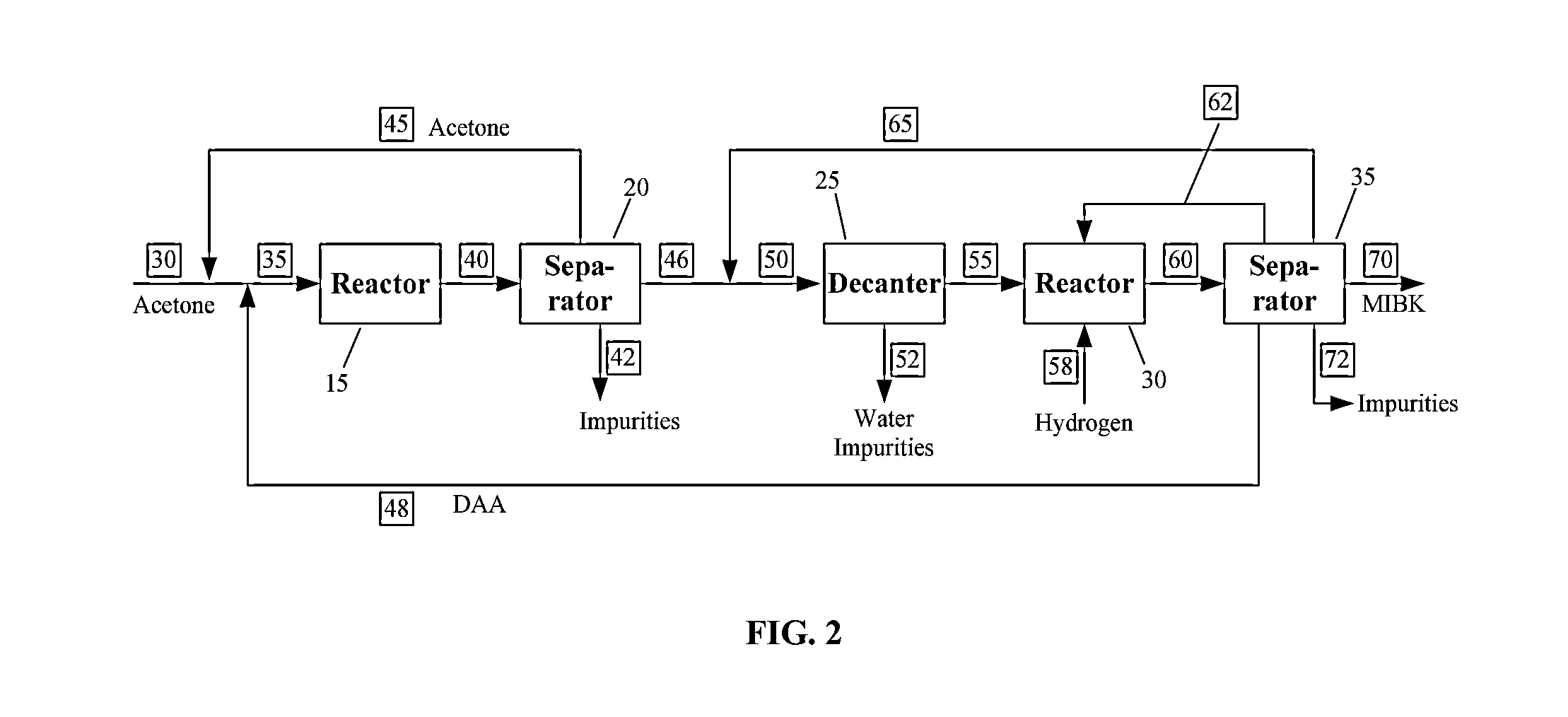Two-step system and method for the production of methyl isobutyl ketone
a technology of isobutyl ketone and reaction process, which is applied in the field of two-step reaction process for the production of methyl isobutyl ketone, can solve the problems of high cost, disadvantageous three-step process, and inability to operate at an elevated pressure, and achieve high purity mibk
- Summary
- Abstract
- Description
- Claims
- Application Information
AI Technical Summary
Benefits of technology
Problems solved by technology
Method used
Image
Examples
example 1
[0044]Example 1 illustrates the need for the present invention. The first reaction step is carried out in a single reactor stage operating at 40° C. and 1 atm. Suitable amount of catalyst is provided to achieve a per pass acetone conversion of 54.6%. The outlet of the first reaction step is sent to a distillation column where acetone is removed as an overhead product. The MO rich stream recovered from the bottom of the column is cooled and sent to the decanter, where it splits into an aqueous and organic phase. The decanter feed has about 5% DAA, leading to a relatively sloppy liquid-liquid split, with a significant amount of DAA lost to the aqueous phase. The DAA concentration in the aqueous phase is 5.9%.
example 2
[0045]Example 2 is also intended show the need for the present invention. The process flow and is identical to that in Example 1. The single reactor stage used for the first reaction step operates at the same conditions as in Example 1, but has a smaller amount of catalyst, leading to a per pass conversion of 30.5%. The DAA concentration in the reactor outlet as well as in the decanter feed are higher than in Example 1. The loss of DAA to the aqueous phase is significantly higher, with an aqueous phase DAA concentration of 20.6%
example 3
[0046]Example 3 illustrates one embodiment of the present invention. The first reaction step is carried out in two reactor stages. The first reactor stage operates at 40° C. and 1 atm. Suitable amount of catalyst is provided to achieve a per pass acetone conversion of about 54%, which is similar to that in Example 1. An additional, or second reactor stage, is provided in this embodiment of the present invention. The second reactor stage is operated at 100° C. and 1 atm, and is provided with just enough catalyst to convert a significant amount of DAA back to acetone, as directed by the changed reaction equilibrium at the higher temperature. The rest of the process flow is similar to that described in Example 1. Due to the conversion of DAA back to acetone in the second reactor stage, the feed to the decanter is lean in DAA. The resulting loss of DAA to the aqueous phase is greatly diminished, with an aqueous phase DAA concentration of only 0.6%. This example is contrasted with Exampl...
PUM
| Property | Measurement | Unit |
|---|---|---|
| Temperature | aaaaa | aaaaa |
| Temperature | aaaaa | aaaaa |
| Pressure | aaaaa | aaaaa |
Abstract
Description
Claims
Application Information
 Login to View More
Login to View More - R&D
- Intellectual Property
- Life Sciences
- Materials
- Tech Scout
- Unparalleled Data Quality
- Higher Quality Content
- 60% Fewer Hallucinations
Browse by: Latest US Patents, China's latest patents, Technical Efficacy Thesaurus, Application Domain, Technology Topic, Popular Technical Reports.
© 2025 PatSnap. All rights reserved.Legal|Privacy policy|Modern Slavery Act Transparency Statement|Sitemap|About US| Contact US: help@patsnap.com



